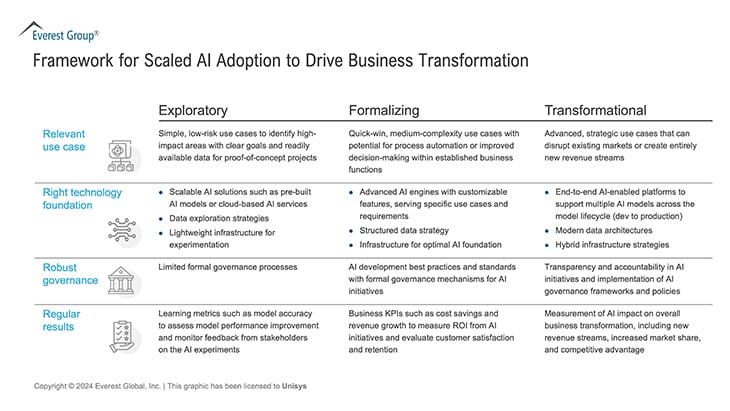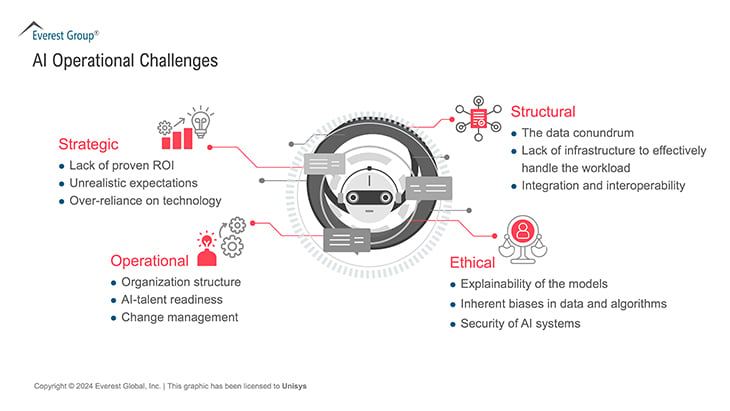From afterthought to AI-first: A playbook for innovation and efficiency
octubre 24, 2024 / Unisys Corporation
Short on time? Read the key takeaways:
- Technological advancements and increasing business maturity have made AI a cornerstone of business transformation strategies. Yet, most organizations have not realized the full potential and intended business impact of their AI investments.
- Organizations can be categorized into three AI maturity levels: exploratory (creating simple proof of concepts), formalizing (implementing pilots into production), and transformational (scaling AI capabilities across the enterprise).
- Organizations face strategic, structural, operational, and ethical challenges in scaling AI. To maximize return on investment, a tailored framework based on the “4R” pillars is recommended: Relevant use case, Right technology foundation, Robust governance, and Regular results.
- As AI is deployed at scale, organizations must prioritize responsible AI practices, addressing fairness, transparency, accountability, and potential biases to ensure sound decision-making and alignment with organizational values. Service providers can help guide organizations in this transition.
In this blog post, Everest Group guest authors (Mukesh Ranjan and Kaustubh K) explore the evolving AI ecosystem, the stages of AI maturity, and a playbook for overcoming challenges and unlocking the full potential of this game-changing technology.
AI holds immense promise for organizations, offering the potential to revolutionize processes, drive innovation, and enable unprecedented levels of efficiency. Its allure lies in its ability to analyze vast amounts of data, identify patterns, and make intelligent decisions.
As a result, organizations are increasing their AI investments to gain a competitive edge in today’s increasingly complex and fast-paced business environment. However, AI has challenges that may limit the return on investment (ROI).
To maximize AI’s benefits, organizations must understand the current landscape and develop a comprehensive adoption strategy. By examining the key drivers, pitfalls, and best practices, they can navigate the complexities of AI implementation and achieve transformative results. Let’s delve into this further.
AI – a business transformation enabler
“There is still a long way to go before we truly become an AI-first world, but the more we can work to democratize access to the technology – both in terms of the tools people can use and the way we apply it – the sooner everyone will benefit.” – CEO, leading global technology firm
AI continues to be a disruptive, essential, and constantly evolving technology. Organizations have embraced AI at a remarkable pace over the past two years, and the exponential surge underscores a transformative shift – from an afterthought to a cornerstone of business transformation strategies across industries. Rather than being considered an “enabler of technology,” organizations have recognized AI as the vital “business transformation enabler.”
But why has AI adoption suddenly surged? The following two key factors are primarily responsible:
- Rising technology advancements: Advances in cloud and data technologies have made AI more intuitive for organizations. Increased computing power, more intelligent algorithms, rapid prototyping, shorter development-to-deployment cycles for machine learning (ML) models, and scalable cloud storage have made AI more accessible. In addition, generative AI (gen AI) has also led to further advancements and applications.
- Increasing business maturity: The growing business maturity towards AI adoption has played a crucial role in fueling its rapid integration into various organizational processes.
Are all firms consistently realizing the impact of AI implementations? Everest Group analysts have observed that organizations with the highest AI maturity achieve nearly three times more impact on customer experience and process efficiency-related outcomes than organizations in the early stages of their AI journeys. Therefore, it becomes critical to measure AI maturity, which can be assessed through the following three maturity levels:
- Exploratory: Organizations at this stage are exploring what AI can do for their businesses. Here organizations are creating simple proofs of concept (PoCs) for specific use cases in silos. These organizations lack any coherent strategy for building the future of AI, and the focus is on quick wins. They do not have defined resources or even business objectives for their investments.
- Formalizing: Organizations at this level are formalizing PoCs/pilots to production. They are implementing user adoption plans to achieve target performance metrics and drive measurable business impact.
- Transformational: These organizations have a mechanism for scaling and promoting AI and machine learning (ML) capabilities. They push industry limits, leverage AI for cutting-edge work, automate processes, and innovate new business models.
Uncovering AI operational challenges
While the exponential growth in AI adoption is a testament to its impact, only a few organizations have successfully unleashed the potential of operationalized AI. According to recent Everest Group estimates, more than two-thirds of organizations investing in AI have yet to realize the intended business impact of their investments. Many organizations run only ad hoc pilots or implement AI in pockets as they struggle with a “scaling chasm” where operationalization remains challenging. The difficulties organizations face can be categorized into the following four themes:
- Strategic challenges: Challenges related to aligning AI initiatives with overall business objectives and long-term strategic goals.
- Structural challenges: Day-to-day implementation and management issues in AI initiatives within the enterprise.
- Operational challenges: Challenges related to organizational structures, processes, and capabilities necessary for AI adoption.
- Ethical challenges: These involve ethical considerations such as bias, privacy, transparency, and societal impacts of AI implementations.
The Everest Group 4R framework for maximizing ROI from AI adoption
In response to the challenges and to maximize ROI, a comprehensive playbook or framework for strategic AI adoption is essential. Since each enterprise’s journey is unique, the one-size-fits-all approach to AI adoption cannot serve the enterprise’s purpose of driving innovation and operational efficiency. A well-defined tailored framework is a roadmap for navigating these challenges, guiding organizations towards successful AI integration and sustainable value creation. Four critical pillars support the framework as illustrated below:
- Relevant use case: This pillar identifies AI use cases that align with organizations’ business objectives and maturity levels. The selection ensures that AI initiatives are focused on delivering tangible value and addressing real-world challenges. For example, an enterprise at the exploratory maturity level may choose natural language processing (NLP) algorithms to automate document processing and chatbots. While at the highest maturity, the firm would use AI for predictive analytics for public policy decision-making.
- Right technology foundation: This pillar focuses on selecting the right technologies, platforms, and tools to support organizations’ use cases. The right tech foundation is essential to successfully implement and operate AI-enabled solutions, allowing organizations to leverage advanced algorithms and techniques to solve complex problems.
- Robust governance: This pillar ensures formal mechanisms and processes are established to manage AI-enabled solutions effectively. It includes defining roles and responsibilities, setting standards and best practices, and ensuring compliance with regulatory requirements and ethical guidelines.
- Regular results: This pillar focuses on measuring and evaluating AI outcomes against predefined metrics and ROI goals based on the enterprise’s current state. Registering results regularly allows organizations to assess the effectiveness and impact of their AI initiatives, identify areas for optimization and innovation, and make data-driven decisions to achieve business objectives.

Click to enlarge
Driving responsible AI throughout the organization
As organizations integrate AI into their system and deploy it at scale, responsible usage considerations are paramount to uphold broader organizational values. Organizations must prioritize fairness, transparency, and accountability to mitigate any bias and discrimination that might creep in. As organizations adopt AI systems to leverage and deploy AI at scale, they must address several questions such as:
- Is the data used to train the algorithm complete, accurate, and free of human bias?
- Is the model being tested with a diverse set of data to ensure reliability in all cases? Is there a human-in-loop?
- Are there algorithmic biases in the system that compromise its sound decision-making capability?
- Are the results reliable enough to make critical decisions based on the algorithms’ recommendations?
- Is there a preference to perform multiple data scans or to prioritize managing associated costs?
- Is there a provision for monitoring potential drift in the dataset over time?
Suppliers are vital partners
As organizations embark on their AI journeys, the extensive network of cloud vendors, independent software vendors, global service providers, and niche AI vendors can help eliminate most of these barriers to AI adoption. This growing ecosystem can democratize access to AI, provide scalable platforms and infrastructure, and enable operating model redesign to transition from siloed to scaled AI adoption. Service providers are uniquely suited to guide organizations with expert talent, a broad partner ecosystem, and many foundation tools and accelerators. By offering services related to technological, cultural, and structural shifts, they can guide organizations toward business-aligned AI adoption and fully realize their promise for innovation and growth.
To see how you can speed processes and drive insights with Unisys and AI, please contact us or visit online.

















